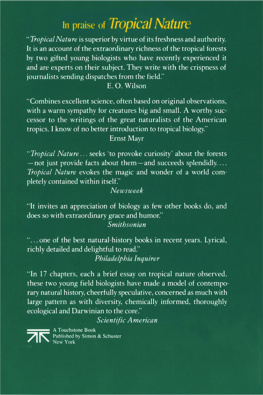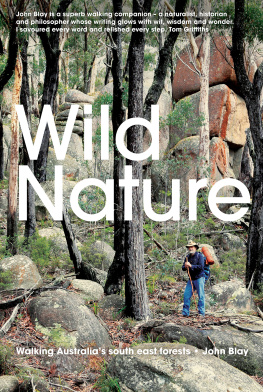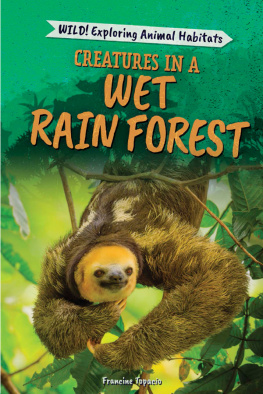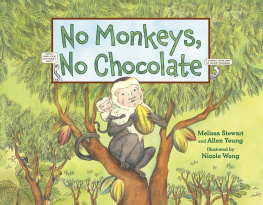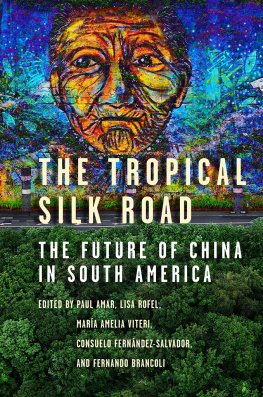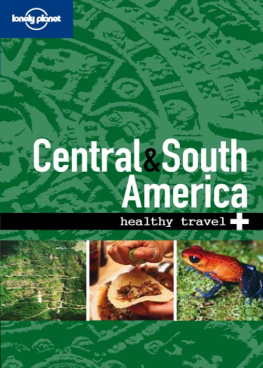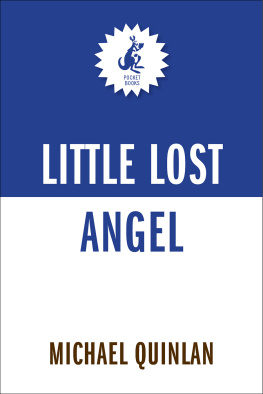
ADRIAN FORSYTH
holds a Ph.D. in biology from Harvard University.
He won the Canadian National Magazine Award for Science Writing in 1982 and 1983, the first author to win the award twice.
KEN MIYATA
also held a Ph.D. in biology from Harvard University,
and worked for the Nature Conservancy in Washington, D.C.
He died in an accident late in 1983.

Also by Adrian Forsyth
Mammals of the Canadian Wild
A Natural History of Sex


TOUCHSTONE
Rockefeller Center
1230 Avenue of the Americas
New York, NY 10020
www.SimonandSchuster.com
Text copyright 1984 Adrian Forsyth and Ken Miyata
Illustrations copyright 1984 Sarah Landry
All rights reserved, including the right of reproduction in whole or in part in any form.
First Touchstone Edition 1995
Library of Congress Cataloging-in-Publication Data
Forsyth, Adrian.
Tropical nature.
Bibliography: p.
Includes index.
1. Rain forest ecologyCentral America. 2. Rain forest ecologySouth America. I. Miyata, Kenneth. II. Title. QH108.A1F67 1984 574.52642098 82-42640 ISBN 0-684-18710-8
eISBN 978-1-4391-4474-9
Manufactured in the United States of America
10 9 8
The excerpt on p. 139 from Sail Away by Randy Newman is copyright 1972 WB MUSIC CORP. & RANDY NEWMAN. All Rights Reserved. Used By Permission.
The excerpt on p. 185 from Farewell, My Lovely by Raymond Chandler is copyright 1940 by Raymond Chandler, copyright renewed 1968 by Mrs. Helga Greene. Reproduced by permission of Alfred A. Knopf, Inc.
CONTENTS
To the memory of Ken Miyata
ILLUSTRATIONS
FOREWORD
Belm, the Amazons port city, lies but 3 hours from Miami, but seems as remote as if the journey were possible only by sail. Even to me as a naturalist, the Amazon seemed remote when, in 1965, it was first suggested that I visit. Only then did I really register that such a city existed, let alone that it dated from 1616 and contained half a million people. I felt embarrassed to be so unaware.
All tropical forests seem touched with this perception of remoteness, even more than the savannahs of Africa with all their great mammals. In large part this is because tropical forests are a world for biological sophisticates, a world the wonders of which only become apparent with considerable patience and background.
I was no exception that June afternoon when I first entered the tropical rain forests on the outskirts of Belm. The first impression was not of tremendous variety as the books of the great naturalist-explorers had taught me to expect. Rather, the mass of vegetation conveyed a sense of green, and of sameness. It was wet and warm but not blistering hot as it was in the sun outside the forest. It was quiet. Little moved except ants.
Superficial as they might seem, these were quite accurate and appropriate perceptions. Ants are a dominant feature of these great forests. The plentiful variety of plant species has been shaped similarly to shed water and discourage epiphytic growth.
Most species of plants and animals are relatively rare and most animals are occupied in not attracting attention.
If that is as far as one gets in making the acquaintance of these wonderful forests, the remaining impression is likely to be one of vague unease about unseen tarantulas and snakes coupled with a sense that the forests are probably, after all, unremarkable. The only cure for such inappropriate ennui has been to see the forest in the company of a modern tropical naturalist, or read the works of those of the nineteenth-century naturalistsbooks always a bit hard to find and, except as reprints, not to be subjected to the rigors of field conditions.
This volume bridges the problem, providing a modern introduction, to those who have cut their naturalists teeth in the temperate zone, to the tropical forests, most particularly those of the New World. A very comfortable introduction it is, providing the most recent insights in tropical biology, in highly readable form. A journey in itself, it is my hope and that of the authors, one of whom died tragically young, that this will be but bait to lure ardent naturalists to partake directly of the fascination of tropical nature.
Timely it is for people to acquaint themselves with the wonders of tropical biology and the problems of tropical deforestation. Tropical biologists such as the authors and myself can take heart in the plight of tropical forests appearing on the front page of the Washington Post on New Years day 1984. Yet, are not most people on reading that touched with the same feeling of remoteness that affected me in 1965?
In the meantime tropical deforestation progresses at a terrifying rate, variously estimated, but in the vicinity of fifty acres a minute. In most instances, because of the peculiarities of tropical ecology, the land becomes rapidly degraded and worth little to society. At the same time, the major portion of our stock of biological resourcesthe half or more of all species of animals and plants of the entire planet that reside in these forestsbecomes seriously threatened. Substantial number of species, many never seen by scientists, have probably already disappeared, while enormous numbers (hundreds of thousands of species) are likely to be lost in the next two or three decades. There is no greater environmental problem.
There are many reasons to be concerned. The forests are important for the useful species and ecological processes they harbor and produce. They are important because laying waste to the land helps no person and creates problems that can reach out and affect the most powerful of nations.
But most of all they are special because this is where life on earth reaches its utmost expression, where systems are richest in numbers of species and where biological systems reach their greatest complexity. Here science is likely to find kinds of arrangements of life forms to be found nowhere else. Surely, to the extent that biology, the study of life, is of value to us as living entities ourselves, it makes sense not to erase the evidence from which to build our knowledge?
Further, in these forests lies a virtually limitless supply of excitement, joy, and wonder to be encountered in new illuminations on the constructs and workings of life on earth.
THOMAS E. LOVEJOY
World Wildlife Fund
PREFACE
This book is based on the ideas and experiences of two different people who have done field work both together and apart. We have chosen to write in the first person plural when writing of experiences we shared, and in the first person singular in our accounts of experiences of only one of us. We found this preferable to relegating our thoughts and observations entirely to the blandness of the third person. Readers who wish to know which I speaks can bear in mind that narratives from Ecuador are usually by Ken Miyata and those from Costa Rica by Adrian Forsyth.
We have asked friends and colleagues to read chapters of this book, to make sure that we made no egregious misstatements of fact. They didnt always agree with our interpretations, but we are grateful for their helpful comments. We thank Dr. Ernest E. Williams of the Museum of Comparative Zoology, Harvard University, Dr. W. Ronald Heyer of the National Museum of Natural History, Smithsonian Institution, Dr. Roy W. McDiarmid of the United States Fish and Wildlife Laboratories, and Dr. Jerry Coyne of the University of Maryland for their efforts to keep us honest. We are also grateful to Sally Landry, our illustrator, and Michael Pietsch, our editor at Scribners, for their helpful suggestions from a nonbiologists perspective.
Next page
